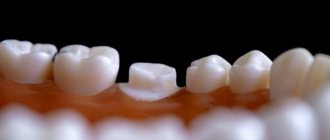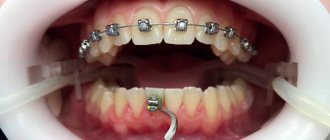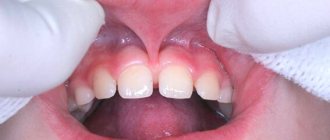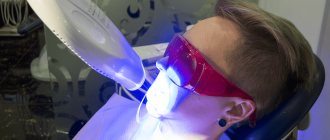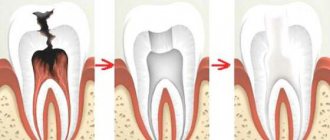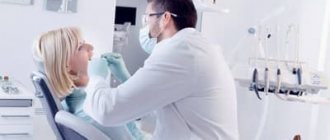Braces are orthodontic structures that help correct malocclusion and also correct uneven teeth. Most often, the bracket system is installed on the entire dental row between the molars. Is it possible to put a brace on 1 tooth or several? How long do partial braces last? Find out in the article.
In this article
- Types of bracket systems
- What dental problems can braces solve?
- How do braces work?
- Partial braces
- Indications for installing partial braces
- Necessary steps before installing partial braces
- Procedure for installing partial braces
- 2 by 4 braces system
- Braces for 4 teeth
- How long should you wear partial braces?
In modern dentistry, there are several different types of braces. If previously all structures were only metal and attached exclusively to the front surface of the teeth, which violated the aesthetics of the smile, now the choice is much wider. Systems are made from different materials in configurations to choose from. Which corrective structure to install depends on the individual characteristics of the patient’s dental system and his budget.
Types of bracket systems
Today the following systems of four types of materials are used:
- Metal. The most common and affordable, and also the most durable. But there are also nuances: if we talk about aesthetics, then metal braces are not the most advantageous option, and some people are allergic to the presence of metal in the mouth.
- Plastic. This type of braces is also quite inexpensive, but they are less durable than stainless steel. An important nuance - plastic structures are quickly stained by coffee, tea, cigarettes, acquiring a yellowish tint. It is better not to choose them for lovers of these drinks or smokers.
- Ceramic. Such designs are selected exactly to match the color of the enamel, so they look aesthetically pleasing and do not spoil the smile, and the ceramics are very durable. But one of the disadvantages of ceramic braces is their high cost.
- Sapphire. They are made from artificially grown sapphire crystals and are recognized as the most beautiful. Single crystals are transparent and invisible on the teeth; moreover, they can be easily cut and given any desired shape. But this type of structure is also quite expensive.
- Lingual braces can be made from any of the listed materials. This is the name of the system that is attached to the inside of the teeth and is invisible to the eyes of others. Such braces are often used when installed on the front incisors while maintaining the aesthetics of the dentition.
Most often, metal dental braces are chosen for correction due to their reasonable cost and practicality. However, in some cases, for example, with the same allergies, it is necessary to consider another type of orthodontic structures.
What factors affect wearing time?
The first factor is the patient's age. Although orthodontic treatment is effective at any age, the older the patient, the longer it will take to correct the bite. The shortest treatment periods are at the age of 13-18 years. During this period, the dental system is still elastic, the muscular-ligamentous apparatus is more mobile. In addition, the removable bite is already being replaced by a permanent one.
Other factors:
- The complexity of the anomaly. Even the most complex dental malformations are easier to correct than an overbite. Therefore, if you have problems with closing your jaws, you will have to wear the device longer.
- System type. Metal models correct anomalies the fastest. Lingual structures are worn longer than vestibular ones. But they are invisible. Sapphire and ceramic braces will have to be worn longer than iron braces.
- Orthodontic experience. When fixing the system, the angle of inclination, height, and width are taken into account. It is important that the doctor does everything accurately. You can wear these braces for a long time without any problems. Therefore, choosing a doctor and clinic is an important step on the path to a healthy smile. Doctors at our clinic constantly monitor the degree of unit displacement and the condition of the patient’s oral cavity. Therefore, bite correction is faster.
- Proper care. Hygiene and following recommendations are no less important than all other factors. After eating, you need to brush your teeth, use a mouthwash and irrigator.
The distal bite is the most difficult and time-consuming to correct. On average, it will take up to 3 years to bring your bite back to normal. A deep bite and elimination of diastema will take 1.5 years or more. At the Propricus clinic, even the most complex malocclusions are corrected. Therefore, you should not worry or be afraid. Age is not a barrier to correcting your bite.
Sign up for free 3D modeling of your future smile!
Make an appointment
*By making an appointment you consent to the processing of your data
What dental problems can braces solve?
Correction systems allow you to solve several dental problems at once:
- correct malocclusion;
- prevent the displacement of teeth adjacent to the removed one;
- align abnormally growing permanent teeth;
- cope with some congenital disorders of the upper and lower jaws.
Braces allow you to straighten crowded or, conversely, too sparsely spaced teeth. How does the structure work and how is the dental row corrected?
How long to wear elastic bands
Rubber bands are elastic bands. This is a small but very important detail. They are used at any stage of treatment. The principle of their influence is similar to an arc. They help guide the movement of the dentition or individual units. They are usually placed in the first six months of treatment. But it is not always the case. Elastics are used in the presence of impacted teeth. Rubber bands help the tooth quickly take its place in the row. In a distal bite, rubber bands pull the jaws closer to each other. The orthodontist decides whether to install traction bars or not. This is as important a tool as braces.
How do braces work?
All dental units are capable of changing their position - turning slightly around their own axis, tilting forward or backward. The corrective action of the braces system is based on this ability to move.
After a detailed examination of the dentition, during which the orthodontist determines the future trajectory of movement of each tooth, he installs braces on the teeth and connects them to each other, giving the fastening arch a certain degree of tension. She begins to put pressure on certain teeth, and they gradually change their position.
While wearing braces, the patient must make regular visits to the dentist, who, if necessary, will increase the degree of arch pressure or, conversely, weaken it.
Braces are usually installed on the entire row of teeth between the molars. But what if only one dental unit needs to be corrected? Is it possible to put braces on one tooth? Many people are often interested in this question: not everyone wants to wear the entire structure on the dentition due to a small correction. So is it possible to put braces on several teeth? Yes, put braces on the 2nd and 4th teeth that need correction, perhaps without affecting the rest.
Duration of treatment
The final decision on the need for treatment should be made by a professional dentist and only on the basis of a complete preliminary examination. A specialist can talk about all types of designs, installation methods and duration of treatment in each specific case. However, even the doctor cannot give the exact timing, because much depends on the individual characteristics of the patient’s body.
As a result of the examination, the doctor names the estimated time frame, discusses the cost of treatment and warns about the need to wear special retainers after the braces are removed. Dental correction is a long-term collaboration between the patient and the orthodontist. While wearing the system, it may be necessary to correct, weaken or, conversely, increase the arc pressure, etc.
The exact period of treatment depends on many factors: the specific age of the person, the severity of existing problems, the type of braces installed, as well as the material from which they are made. For mild pathologies, the duration will be about a year, in complex cases – about two years.
previous post
Is it possible to go to the bathhouse after tooth extraction?
next entry
Partial braces
Orthodontists use this type of construction in cases where it is necessary to correct deficiencies in only one of the jaws or at the initial stage of complex treatment. Partial braces are used for minor malocclusions caused by the misalignment of one or two teeth. The system is optimal when it is necessary to correct local tooth curvature in one area of the dental row.
This design is installed on only one jaw, and this is a very convenient solution: a partial braces system is significantly cheaper in cost than a full-fledged one, and it also does not create inconvenience when chewing food. But to use it, a number of conditions must be met.
Why do you need rubber bands when wearing braces?
Rubber bands or elastic bands connect the braces together in certain areas. They are needed to guide the teeth and create the necessary tension force. Tractions are used mainly for pronounced malocclusions to make treatment more effective and faster. The doctor will determine how long to wear elastic bands on braces: the time frame can vary from several weeks to several months.
Indications for installing partial braces
To install braces on one or more teeth, certain indications are required, without which they cannot be attached purely technically:
- the diastema between the teeth should not be more than 3 mm wide;
- only one or more teeth should have a slight curvature, and the rest should close correctly;
- absence of problems with bite, including the important position of the molars relative to each other.
It must be understood that not all of the listed indications have. And even if you want to install partial braces, the doctor cannot do this due to non-compliance with the conditions. According to statistics, partial braces do not exceed 5% of the total number of corrective systems.
What is a good orthodontist?
Personally, I am always in favor of the patient receiving at least two third-party opinions. Orthodontic treatment must be approached very seriously, because you are committed to a relationship with the doctor for 1-2 years (or even more). Without mutual understanding, orthodontic treatment is doomed! There are several most important criteria when choosing a doctor:
- High-quality collection of information/diagnostic data
The doctor must make impressions, then carry out calculations on the models, study the OPTG image or CBCT (3-D image), and take intraoral photographs. ONLY after this can you begin treatment with the bracket system. Taking photographs is also a very important diagnostic step.
- Reviews and reputation
I won’t say obvious things here, but it’s worth paying more attention to the doctor’s actual work, rather than reviews on his personal page. By the way, negative reviews are often really unsolicited, but they can be found for literally every doctor (even the best of the best), so filter the information received. Well, no one canceled the recommendations of friends.
- Availability of diplomas/certificates
Having certificates is far from an empty phrase. This suggests that the doctor wants to develop in his field and know about new developments in the field of medicine. Do not hesitate to ask questions about where the doctor received his knowledge, practice, etc.
- Employment
Sometimes we have to work quickly, on the fly. But alas, the case is not always immediately clear. And in general, orthodontics is a science where you need to think a lot. After all, bite alignment is a kind of arcade game for the doctor. Just clarify what the doctor's plans are for you and make sure that the doctor treats your case carefully.
Orthodontists KANO
Necessary steps before installing partial braces
Before installing braces, the patient must undergo several procedures, based on the results of which the doctor will be able to make a full assessment of the condition of the dental row:
- visual inspection;
- manual diagnostics;
- taking an impression of the jaw;
- computed tomography of the jaw;
- selection of the optimal braces design, taking into account the structure of the dentition and the patient’s budget.
After these preparatory stages have been completed, the specialist proceeds to installing partial braces.
What do braces fix?
Braces are used to correct bites and eliminate various pathologies. Among the indications:
- malocclusion – problems with the closure of the dentition;
- disproportionate development of the jaws;
- displacement of individual teeth beyond the jaw row;
- jaw deformation during formation;
- large gaps between teeth.
Many bite problems are visible even to non-professionals, but some anomalies will only be noticed by a specialist. Dentists strongly recommend that you periodically show your child to an orthodontist to monitor the change of teeth, evaluate the growth of the jaw bones, and monitor the work of the facial muscles.
Procedure for installing partial braces
Based on the data obtained from photographs of the dental row, the orthodontist begins their installation. They are attached as follows: micro-locks are glued to the teeth, and then an arch is attached to them with a certain tension. It is she who puts pressure on the teeth, helping them take the correct position. Installing braces on several teeth (2 or more) is completely painless and does not cause discomfort to the patient.
Many people are interested in whether it is possible to put braces on one tooth. Dentists answer that this is impossible, because braces are a specific system that requires at least four teeth to attach.
Does installation and wearing hurt?
Of course, there are discomforts. In particular, they are caused by the archwire inserted into the braces. There is also discomfort when moving teeth. But there is no pronounced pain that prevents me from speaking, eating, sleeping and preventing me from living normally. First of all, because the force of the arcs is strictly dosed. All movements occur gradually, with a step-by-step increase in the power and size of the arcs - from weaker to stronger, from round to faceted, from thin to thick (full-groove). As for unusual tooth movements, this is a matter of habit, which will appear in 1-2 months.
Let us remind you that all the discomfort during treatment comes down only to the peculiarities of nutrition and brushing your teeth. In the first case, a certain revision of the diet is required, with the rejection of certain foods, and in the second, strict self-discipline. That's all the “inconvenience”.
2 by 4 braces system
This is the name of a common method of attaching braces for the treatment of mixed dentition in children: the orthodontic system is installed on 2 molars and 4 incisors (hence the name). The recommended age for a child to have braces installed is 8-10 years. Braces can be placed on the upper or lower jaw, or on both at once.
Indications for installing a partial 2 by 4 bracket system:
- one or a pair of teeth growing incorrectly, causing discomfort to the child;
- too large interdental gap (often happens in children between the front incisors);
- lack of space for erupting teeth;
- early removal of baby teeth - this can later lead to malocclusion.
Installing partial braces will not help completely correct the bite, since all permanent teeth have not erupted. The 2 by 4 system is often a preparatory stage before wearing a full brace system. Considering that the enamel of children's teeth at this age is not yet strong, it is not recommended to install a partial system for a long time. In addition, children are usually not very careful about dental hygiene without proper supervision, and insufficient care of braces can lead to complications, such as caries.
After the permanent lateral teeth erupt, the partial bracket system is removed, and to maintain the result, the doctor installs a retainer - a special orthodontic splint that controls the position of the permanent teeth.
Caring for braces after installation
Caring for braces after installation is more difficult than caring for teeth without them. There are more hard-to-reach places in the mouth to clean, and plaque forms faster. It is necessary to responsibly follow all the doctor’s recommendations so that later, after straightening, you do not have to put fillings on all your teeth. You will need an orthodontic brush, brush, dental floss and irrigator.
How to care for braces after installation?
- Teeth with braces must be brushed 3–4 times a day, slowly and thoroughly, ideally for 10–15 minutes. It is recommended to use a special orthodontic brush: you can recognize it by the inscription Orthodontic or Ortho. You will also need a brush to help clean your teeth around the braces. Dental floss can handle even the smallest food debris. An irrigator - a device that can clean the most inaccessible places - completes the care.
- Sticky food is a no-no as it can get stuck under your braces. It is better to postpone sweets, especially toffees, until after treatment, as well as foods and drinks high in sugar and acids.
- Sapphire, ceramic and plastic braces require an expanded list of limited products. Drinks containing high amounts of dyes—tea, coffee, soda, and some juices—can affect the color of your orthodontic system.
- In the first days after installing braces, it is not recommended to eat solid food. As for small children, everything should be pureed and liquid. This even applies to fruits. Anything that needs to be chewed is excluded. You can use meat, but be careful not to get stuck in the fibers. It is better to choose tender varieties and cut into small pieces.
If it is not possible to brush your teeth after eating, you should at least rinse your mouth. Even if you care for your braces according to all the rules, periodically undergo professional cleaning and rinse your mouth with a fluoride solution.
How long should you wear partial braces?
In adults, the period of use of partial corrective structures ranges from 6 months to 10 months; for a child, it can last for two years until all permanent teeth appear. For the effectiveness of treatment and timely adjustments when wearing partial braces, it is necessary to visit the orthodontist once a month. If you ignore this rule, you may end up not getting the effect of wearing braces: money and time will be wasted.
Before installing partial braces, the condition of the teeth and gums must be in perfect order: all dental diseases have been cured and hygienic cleaning has been carried out. Any braces systems are installed only in a healthy oral cavity.
Who should not get braces?
Installation of braces has contraindications:
- Absolute – it is not possible to eliminate them: complete absence of teeth (edentia) or the absence of a large number of them;
- changes in the bone tissue of the jaw, leading to its fragility - osteoporosis and osteochondropathy;
- severe diseases of the blood, cardiovascular, endocrine (diabetes mellitus) systems;
- oncological diseases;
- tuberculosis, AIDS;
- mental illness.
- infectious-inflammatory and degenerative-dystrophic diseases of periodontal tissues (periodontitis, periodontal disease);
After treatment of these diseases, braces can be installed.

